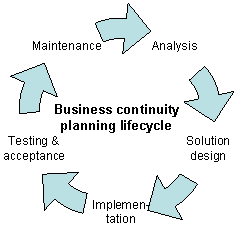Business continuity planning
Business Continuity Planning (BCP) is the process by which organizations prepare for, respond to, and recover from potential threats to their normal operations. These threats can include natural disasters, cyber-attacks, pandemics, and other disruptive events. The goal of BCP is to ensure that critical functions can continue during and after a disaster or emergency situation and to minimize the disruption to business operations.
Overview[edit | edit source]
Business continuity planning involves identifying an organization's exposure to internal and external threats and synthesizing hard and soft assets to provide effective prevention and recovery for the organization. The resilience, recovery, and contingency plans are key components of BCP. It is a proactive planning process that ensures critical services or products are delivered during a disruption.
Key Components[edit | edit source]
The key components of a business continuity plan include:
- Risk Assessment: Identifying the various risks that could affect the organization's operations.
- Business Impact Analysis (BIA): Assessing the potential impacts of an interruption to critical business operations.
- Recovery Strategies: Developing strategies to recover business operations to an operational state within a reasonably short period.
- Plan Development: Writing the business continuity plan based on the findings from the risk assessment, BIA, and recovery strategies.
- Testing and Exercises: Regular testing and exercising of the plan to ensure its effectiveness and to make improvements.
Implementation[edit | edit source]
The implementation of a business continuity plan involves several steps:
1. Policy and Program Management: Establishing the governance of the BCP program including policy, objectives, and roles and responsibilities. 2. Understanding the Organization: Conducting a business impact analysis and risk assessment to understand the threats to business operations. 3. Determining Business Continuity Strategies: Identifying and selecting strategies to mitigate risk and continue operations. 4. Developing and Implementing a BCP Response: Creating the business continuity plan and implementing it. 5. Exercising and Maintaining the BCP: Regularly testing the plan to ensure it remains effective and up to date.
Challenges[edit | edit source]
Some of the challenges in business continuity planning include:
- Keeping the plan up-to-date with changes in the business environment.
- Ensuring employee awareness and understanding of the plan.
- Balancing the costs of implementing BCP measures against the potential benefits.
- Integrating BCP with other organizational processes and plans.
Benefits[edit | edit source]
The benefits of a well-structured business continuity plan include:
- Minimizing disruption to operations.
- Reducing the risk of financial loss.
- Protecting the organization's reputation.
- Ensuring the safety and well-being of employees.
- Compliance with legal and regulatory requirements.
Conclusion[edit | edit source]
Business continuity planning is an essential process for organizations to ensure they can continue operations during and after a disaster or emergency. By identifying potential threats and developing strategies to mitigate these risks, organizations can protect their assets, maintain their reputation, and ensure the safety of their employees.
- Need help finding a doctor or specialist anywhere in the world? WikiMD's DocFinder can help with millions of doctors!
| This article is a stub. Help WikiMD grow by registering to expand it. |
Navigation: Wellness - Encyclopedia - Health topics - Disease Index - Drugs - World Directory - Gray's Anatomy - Keto diet - Recipes
Search WikiMD
Ad.Tired of being Overweight? Try W8MD's physician weight loss program.
Semaglutide (Ozempic / Wegovy and Tirzepatide (Mounjaro) available.
Advertise on WikiMD
WikiMD is not a substitute for professional medical advice. See full disclaimer.
Credits:Most images are courtesy of Wikimedia commons, and templates Wikipedia, licensed under CC BY SA or similar.
Contributors: Prab R. Tumpati, MD

